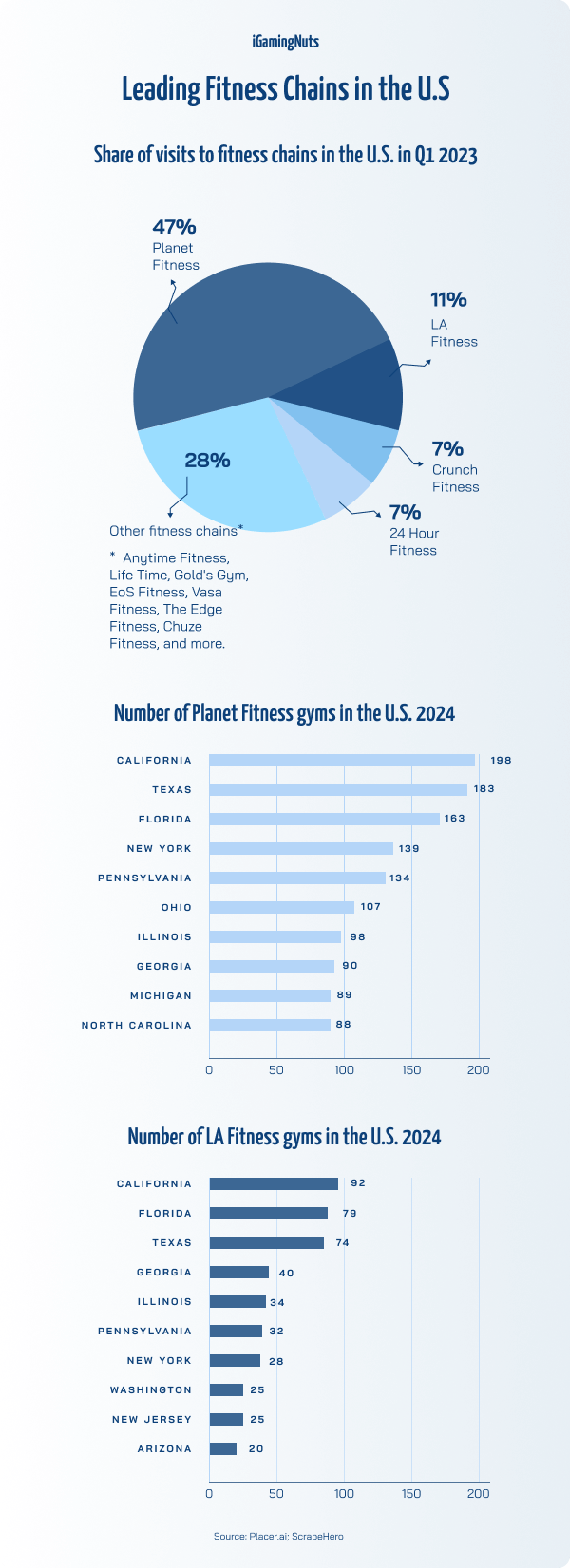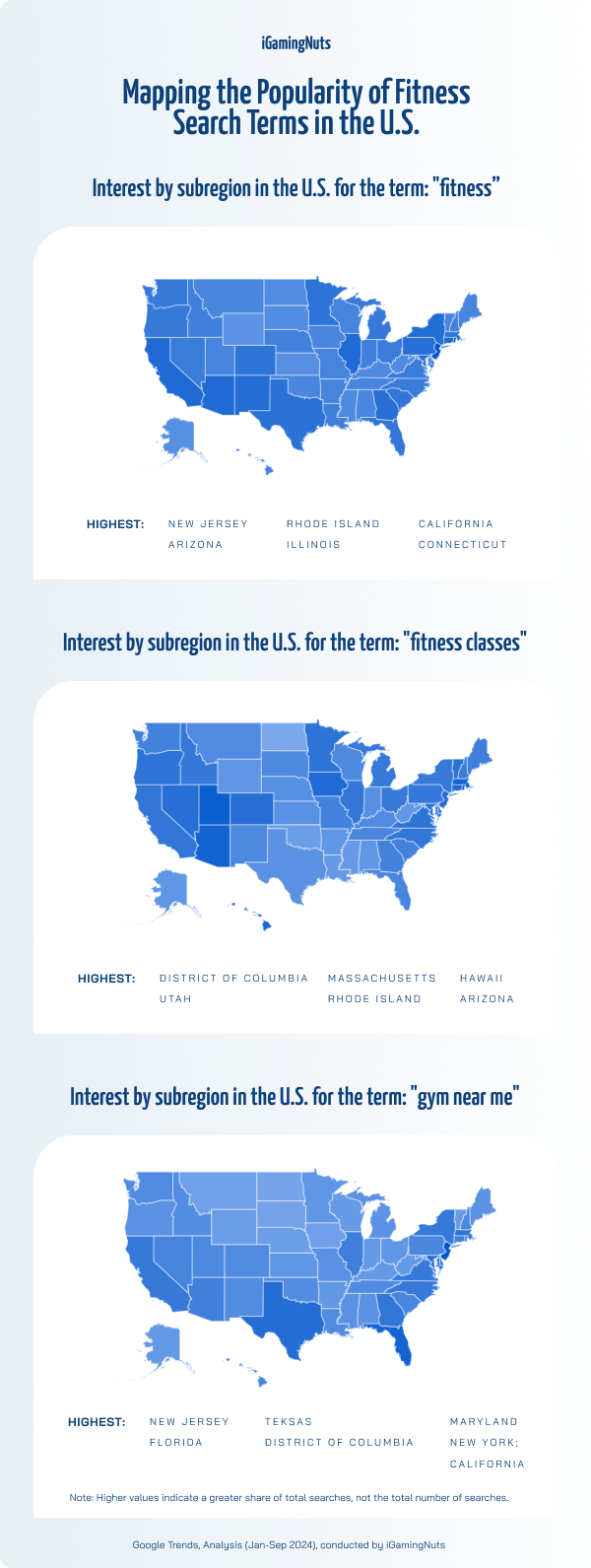America’s Fittest States: A State-by-State Breakdown
Fitness is no longer just about physical health. It has become an integral part of daily life, bringing communities together in fitness clubs across the nation. Let’s explore which U.S. states love fitness the most.
Key Takeaways:
- California reigns supreme in the fitness industry, boasting over 5,123 gyms and fitness centers as of 2021.
- Planet Fitness dominates the U.S. gym market, attracting nearly half of all gym visits in the first quarter of 2023.
- San Francisco sets the standard for gym membership rates, with over 21.6% of its residents holding gym memberships.
- A Google Trends analysis from 2024 shows that states like New Jersey, Arizona, and Rhode Island have the highest interest in fitness-related search queries.
- Southern states like Mississippi, Louisiana, and Alabama face challenges with high rates of physical inactivity and obesity.
Number of Gyms and Fitness Centers in Various U.S. States
California leads the country in the number of gyms and fitness centers, with over 5,123 facilities in 2021. Texas and Florida follow closely, with 3,285 and 2,809 fitness centers respectively. New York ranks next with over 2,263 fitness facilities. The higher the number of centers, the greater the competition, which often results in better services and more attractive offers for residents, encouraging them to stay active.
Popular Gym Chains and Market Share
When looking at specific chains, Americans prefer Planet Fitness and LA Fitness. In the first quarter of 2023, Planet Fitness accounted for over 47% of gym visits. LA Fitness had nearly 11%. Crunch Fitness and 24 Hour Fitness were also popular, with each attracting around 7% of gym-goers. Together, these four chains represent 72% of the market share, highlighting their dominant presence in the U.S. fitness industry.

Number of Planet Fitness and LA Fitness Locations by State
Planet Fitness has the most locations in states with the largest number of fitness centers. As of June 2024:
- California: 198 locations
- Texas: 183 locations
- Florida: 163 locations
- New York: 139 locations
- Pennsylvania: 134 locations
LA Fitness also has a strong presence. As of May 2024:
- California: 92 locations
- Florida: 79 locations
- Texas: 74 locations
- Georgia: 40 locations
- Illinois: 34 locations
Gym Penetration Rate in Selected Metro Areas in the U.S.
While state-level data is insightful, examining gym membership rates in specific metropolitan areas provides a deeper understanding of fitness engagement:
- San Francisco – 21.6%
San Francisco boasts the highest gym penetration rate among all listed cities, with over 21.6% of residents holding gym memberships. This indicates a high level of physical activity engagement. San Francisco is known for promoting a healthy lifestyle, with numerous initiatives such as Vision Zero SF, a program that promotes active mobility. - San Diego – 19.3%
San Diego has a well-developed health and fitness culture, with over 19.3% of its population using gyms. The high availability of fitness infrastructure makes physical activity an appealing option for residents. - Atlanta – 19.3%
Atlanta also shows strong engagement, with 19.3% gym penetration. The city’s investment in fitness infrastructure contributes to residents’ active lifestyles.
Other notable cities include Seattle (18.4%), Salt Lake City (17.9%), Boston (17.4%), New York (16.8%), and Sacramento (15.9%).
California: A Hub of Physical Activity and Fitness Facilities
With over 5,123 fitness facilities, California boasts one of the most developed fitness infrastructures in the U.S. Cities like San Francisco, San Diego, and Sacramento exemplify the state’s high interest in gym-based physical activity. Physical appearance and health are integral to daily life, heavily influenced by the entertainment industry and a societal focus on aesthetics. The presence of Hollywood and prominent media industries fosters a culture where physical fitness is highly valued and often linked to professional success.
California frequently sets trends in the wellness industry, from diets to the latest fitness movements promoted by media and health influencers. A prime example is actor Mark Wahlberg, who promotes the F45 gym chain. The state’s emphasis on fitness, healthy eating, and a lifestyle balancing body and mind has made California a symbol of physical activity and wellness.
Americans’ Commitment to Physical Activity
Americans are increasingly committing to physical activity. In 2021, over 67% of the U.S. population participated in fitness sports. This term encompasses a wide range of activities, including running, strength training, and gym workouts, which translates to around 156.5 million people.
In 2024, Americans are most likely to choose hiking as their form of physical activity—34% of them regularly hit the trails. Fitness exercises, aerobics, and cardio come in a close second, attracting 33% of Americans. This highlights the growing interest in activities that offer both exercise and relaxation in nature.

The Least Physically Active States
Physical inactivity and obesity rates in the U.S. are closely linked, and many states with the highest levels of inactivity also have the highest rates of obesity. For example:
- Mississippi: 33.2% physically inactive, 39.5% obesity rate
- Louisiana: 30.8% physically inactive, 40.1% obesity rate
- Alabama: 30.7% physically inactive, 38.3% obesity rate
Other states with high physical inactivity and obesity rates include:
- West Virginia: 30.1% inactivity, highest obesity rate at 41%
- Tennessee: 28.9% inactivity, 38.9% obesity rate
- Oklahoma: 30.5% inactivity, 40% obesity rate
A lack of physical activity is one of the key factors contributing to rising obesity rates in many states. But not only that. States like Texas and Georgia have relatively high access to gyms while simultaneously having high obesity rates.
Texas and Georgia: High Obesity Rates Despite Numerous Gyms
Despite an abundance of gyms, Texas (35.5% obesity rate) and Georgia (37%) face high obesity levels. This paradox arises from several key factors:
- Socioeconomic Conditions: From 2022 to 2023, per capita income growth was 5.2% in Texas and 4.5% in Georgia, both below the national average of 5.6%. Slower income growth limits residents’ ability to afford gym memberships and healthy food. In Texas, income disparities are evident: diabetes prevalence is 24.3% among those earning less than $25,000 annually versus 10.9% among those earning $75,000 or more.
- Cultural Dietary Habits: Both states favor traditional Southern cuisine rich in calories, saturated fats, and sugars—fried foods, grilled meats, and sweetened beverages—contributing to excessive calorie intake.
- Low Physical Activity Levels: Physical inactivity exceeds the national average (25.3%), with 27.5% of adults inactive in Texas and 27.4% in Georgia. Sedentary lifestyles may result from cultural norms, occupational demands, and increased screen time due to technology use.
- Education and Health Awareness: The percentage of residents with higher education is slightly below the national average (33.7%): 33% in Georgia and 31.5% in Texas. Lower education levels may lead to limited health awareness, affecting diet and exercise choices.
- Healthcare Access: In health system rankings, Georgia is 48th (score: 48.61) and Texas is 46th (score: 49.39), indicating limited access to medical services, preventive care, and health education, which hinders obesity prevention and management.
High obesity rates in Texas and Georgia result from economic barriers, cultural dietary preferences, low physical activity, and limited access to health education and care. Addressing these issues requires a comprehensive approach targeting these underlying factors.
Fitness Popularity by State: Google Trends Analysis 2024
In our original study conducted in 2024, we utilized Google Trends to determine the level of interest in fitness-related topics across U.S. subregions. We analyzed search phrases such as “fitness,” “fitness classes,” and “gym near me” from January to mid-September 2024.

Interest in Fitness: Top States for General Fitness Searches
For the term “fitness,” the highest interest was recorded in:
- New Jersey
- Arizona
- Rhode Island
Other high-ranking states include Illinois, California, and Florida. California, with more than 5,000 fitness facilities, has one of the most developed fitness networks in the U.S. Its obesity rate is 28%, one of the lowest in the country. Florida, with strong interest in gyms, also shows a significant fitness culture. These regions clearly have a strong culture of physical activity and advanced sports infrastructure.
“Gym Near Me”: States Leading the Search for Gyms
The analysis of the phrase “gym near me” reveals similar trends, with the highest interest in gyms found in:
- New Jersey
- Florida
- Texas
In New Jersey, where the obesity rate is 29%, the availability of gyms and a penetration rate of 17% support residents’ healthy lifestyles. In Florida, despite an obesity rate of nearly 32%, interest in gyms remains high.
Fitness Classes: Regions with the Highest Engagement in Group Fitness
Data on the term “fitness classes” shows significant interest in:
- District of Columbia
- Utah
- Massachusetts
These states are known for high levels of physical activity. For example, in the District of Columbia, only 20.2% of adults are physically inactive, one of the lowest rates in the U.S. Similarly, Utah has a physical inactivity rate of 18.2%.
Challenges Facing the Fitness Industry
Despite impressive growth, the U.S. fitness industry faces significant challenges that threaten its continued expansion. Inflation, which reached 8% in 2022, has led to rising costs of energy, rent, and employment. Consequently, many gyms have experienced operational cost increases of up to 15% year-over-year. Smaller fitness facilities, operating on thin margins, are particularly affected, potentially impacting accessibility for consumers.
According to RunRepeat, 67% of gym members never actually use their memberships. Moreover, IHRSA reports that 50% of all new gym members quit within the first six months. PTPioneer adds that 41% of gym membership cancellations in the U.S. were due to cost, 25% due to changing personal circumstances, and 19% believed they could achieve their fitness goals independently. These figures highlight challenges in member retention and the perceived value of gym memberships.
Optimism Amid Industry Challenges
Despite these obstacles, gym operators remain optimistic. Reports show that 86% of consumers worldwide declare that health and fitness have become priorities for them, presenting opportunities for further industry growth. For instance, in January 2023, the number of fitness center visits increased by 249% in the District of Columbia and by 56% in Hawaii compared to the previous year. This surge is a strong signal of the fitness sector’s recovery post-pandemic.
Technological innovation is the industry’s answer to staffing shortages and changing consumer preferences. The popularity of fitness apps is rising, with platforms like Peloton, Fitbod, and ClassPass allowing users to access personalized workouts without direct contact with a personal trainer. The global fitness app market is expected to reach a value of $14.64 billion by 2026. The surge in these apps during the pandemic continues, providing an effective solution to staffing challenges in traditional gyms.
The United States is also at the forefront of the global personal training industry. With around 840,000 personal trainers employed across the country in 2023, the U.S. accounts for 44% of the global personal training market. This leadership reflects the high demand for personalized fitness services and underscores the importance placed on health and wellness in American society.
The Popularity of Fitness in the U.S.
Based on the data analysis, the states that love fitness the most are California, New Jersey, Florida, Utah, and the District of Columbia.
California and New Jersey: Leaders in Fitness and Health Trends
California stands out with its extensive fitness infrastructure and culture. With over 5,123 fitness facilities and an obesity rate of 28.1%, it leads by example in promoting a healthy lifestyle. Cities like San Francisco have gym penetration rates as high as 21.6%.
New Jersey also demonstrates a high level of physical activity, with a gym penetration rate of 17% and an obesity rate of 29.1%. The state’s significant interest in fitness-related searches indicates a strong fitness culture.
Florida and Utah: Strong Engagement in Physical Activity
Florida boasts a large number of gyms and strong resident engagement in physical activity. Despite having an obesity rate of 31.6%, the state’s popularity in fitness centers suggests a commitment to health and wellness.
Utah, with one of the lowest physical inactivity rates at 18.2%, shows strong engagement in fitness, supported by its well-developed sports infrastructure.
The District of Columbia: Fitness as a Daily Lifestyle
The District of Columbia, with a physical inactivity rate of 20.2% and an obesity rate of 24.3%, confirms that well-developed fitness infrastructure and active communities play a key role in promoting healthy lifestyles. The high level of interest in fitness classes shows that fitness has become an integral part of daily life for residents.
Conclusion: Embracing a Healthier Lifestyle
These states stand out thanks to their well-developed fitness infrastructure and resident engagement in physical activity. This leads to better health outcomes and greater interest in maintaining a healthy lifestyle. As fitness becomes a priority in people’s lives, exploring fitness options in one’s community can be the first step toward a healthier, happier lifestyle.
Table: Key Fitness Statistics by State
| State | Gym Number Category | Obesity | Physical Inactivity | Fitness Interest (Google Trends) |
|---|---|---|---|---|
| California | High | Low (28.1%) | Low (21.2%) | Moderate |
| Texas | High | High (35.5%) | Moderate (27.5%) | Moderate |
| Florida | High | Moderate (31.6%) | Moderate (27.3%) | Moderate |
| Georgia | Moderate | High (37.0%) | Moderate (27.4%) | Moderate |
| Illinois | Moderate | Moderate (33.4%) | Moderate (24.9%) | Moderate |
| New York | Moderate | Moderate (30.1%) | Moderate (25.9%) | Moderate |
| New Jersey | Low | Low (29.1%) | Moderate (27.2%) | High |
| Arizona | Low | Moderate (33.2%) | Moderate (23.3%) | High |
Methodology
To conduct the analysis of fitness popularity across U.S. states, a diverse set of statistical data was utilized to create a comprehensive overview. The collected information encompassed categories such as number of gyms, obesity rate, physical inactivity, and fitness interest according to Google Trends.
Fitness Interest (Google Trends): The level of fitness interest in individual states was determined based on an analysis of Google Trends data for key phrases: “fitness,” “fitness classes,” and “gym near me.” This data covered the period from January to mid-September 2024. For each state, an average of the results for these phrases was calculated, allowing for the assignment of a category: high, moderate, or low interest.
The data processing and analysis involved calculating average values and categorizing data according to established thresholds. This approach facilitated comparisons between states and the identification of those that stand out in terms of fitness popularity. States lacking data in any category were omitted from the analysis to maintain consistency.
